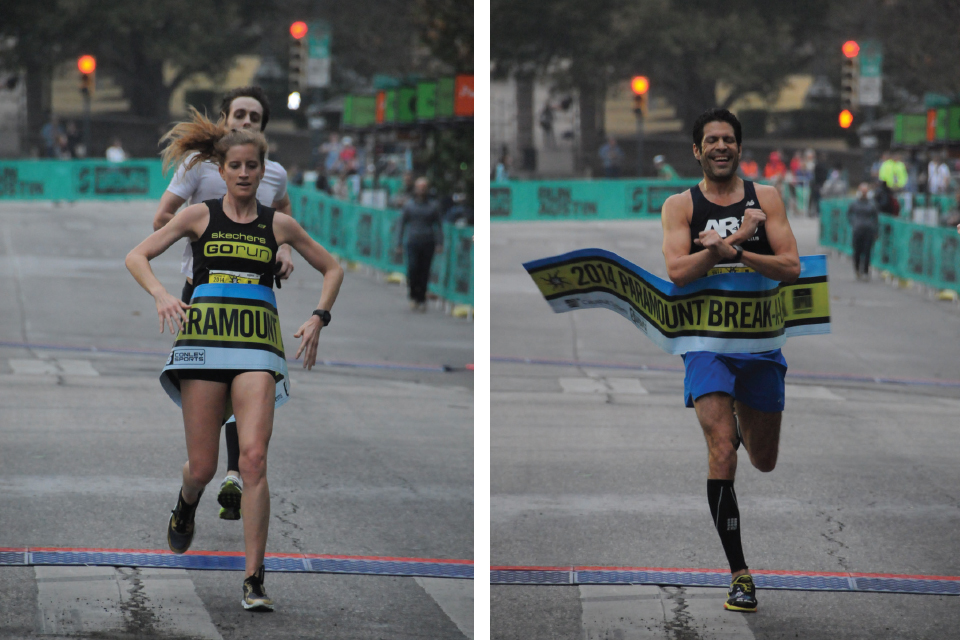Charity Runners Log Miles to Benefit Many

Almost a decade ago, Peggy Sharp found out she had breast cancer, just a few months after her sister, Jackie, was diagnosed with leukemia. She started volunteering with the Susan G. Komen organization and American Cancer Society to help raise funds for cancer research. Five years ago, her massage therapist pitched an idea that at the time Sharp thought was somewhat insane: Run a marathon.
“She told me I had to do a little race—she didn’t tell me it was a marathon,” Sharp said. “I said, `Are you crazy, I’m supposed to run that?’ I hadn’t run since college.”
In the ensuing months, she raised $3,900 for the Leukemia and Lymphoma Society through its Team in Training (TNT) program while training for and finishing the 2009 San Diego Rock ‘n’ Roll Marathon. Since then, she’s participated in 16 events and raised $70,000 for the organization.
Raising money for everything from cancer research to animal shelters has become a major source of revenue for nonprofit organizations. TNT, for example, has raised $1.4 billion for blood cancer research since its inception in 1988, said Colin Novelli, 27, director of the Austin-based south-central Texas chapter.
The Austin Gives Miles program, the fundraising arm for the Austin Marathon, raised $336,000 for the 2014 26.2-mile race and gathered half of the event’s volunteers, said Carly Samuelson, 36, the charity coordinator for the program. Charities are required to provide volunteers to staff an aid station or bag-check area, and in return, receive donations made through Austin Gives Miles, Samuelson said.
While some groups (including TNT, the Team to End AIDS, and Team Red, White and Blue) provide training or support to participants who wear their racing kits at events and during training, others raise funds through race-entry fees. The Paramount Theatre, which will turn 100 years old in 2015, raises money to help pay for upkeep of the building through entry fees from its Break-A-Leg 5K (3.1 miles). That run is held on the same day as the Austin Marathon, which keeps infrastructure costs down, said Cathy McDonald, 53, associate director of special events for the theater. According to McDonald, the race—an offering to people who aren’t prepared to run 26.2 miles or are friends or family members of a marathon runner—earlier this year raised $40,000 for the theater.
“We have a great number of people come in from outside city, state, and country—[marathon participants] don’t come here alone,” McDonald said. “Often, those people are in the fitness community. They may not be prepared to run a marathon, but they may want to get their own workout in while whoever they’re supporting is running, so we found that was kind of a neat draw.”
The Dogs Out Loud program began partnering with the marathon’s Austin Gives Miles program last year, raising $2,500 to support in-shelter behavior intervention programs at the Austin Animal Center, support foster dogs, and provide training scholarships for its alumni. The money also goes to purchase a myriad of items, from leashes and harnesses, to toys and treats, said Amy Fitzsimmons, the director for Dogs Out Loud.
Participation in endurance events has exploded in the past 25 years, with the number of people running marathons more than doubling since 1990, according to Running USA. While the number of participants has risen, so has the number of races. In 2013, 1,100 marathons took place in the U.S., the group said. That means charity dollars are being spread over more events, resulting in a plateau effect with regard to the number of participants and funds raised, TNT’s Novelli explained.
Still, millions of people globally run races of varying distances to raise money for charities. Peggy Sharp, the breast cancer survivor who races with the TNT group, lost her sister, Jackie, in 2012 to leukemia, breast, and bone cancer. It’s partly her sister’s memory and the needs of people who are new to the program that keep her running. Having that support group is what makes running with a charity worthwhile, Sharp said.
She plans to run the New Orleans marathon in 2015, and since she turns 60 that year, Sharp said she’ll squeeze in a triathlon—Ironman Victoria 70.3 in Canada.
“I’m one of the lucky people. My cancer was nothing compared with what I saw my sister and some other friends go through,” Sharp said. “It’s never easy to run a marathon. When things get tough [on the marathon course], I think of my sister and my other friends and I think about the people out there fighting for their lives. And I think, `I can do this, because I can walk, and because I’m healthy.’”
To learn more, read these related articles on austinfitmagazine.com
Austin Gives Miles: The philanthropy wing of the Austin Marathon and Half Marathon
supports local charities
Readjusting after Combat: Using Fitness to Smooth Veterans’ Return
Reader Transformation Stories: How the Marathon Saved My Life, by Michael Cates






